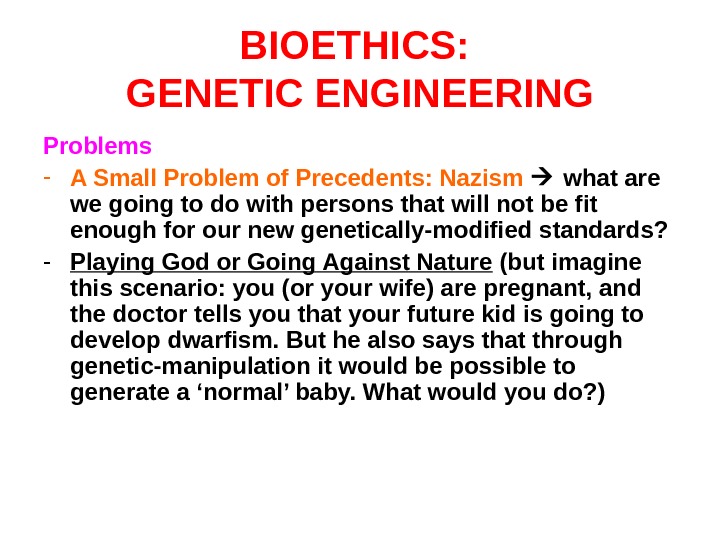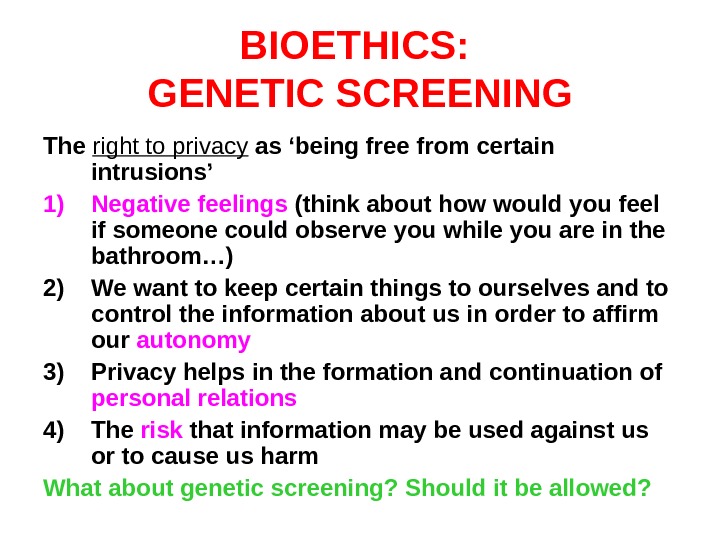Genetic engineering Genetic engineering • 1953:








- Размер: 27.5 Кб
- Количество слайдов: 7
Описание презентации Genetic engineering Genetic engineering • 1953: по слайдам
 Genetic engineering
Genetic engineering
 Genetic engineering • 1953: J. Watson de-codified the structure of DNA. • It had positive and negative results. • the access to genetic information of a person can have negative consequences (even discrimination); • main question: should everything that technically possible be allowed?
Genetic engineering • 1953: J. Watson de-codified the structure of DNA. • It had positive and negative results. • the access to genetic information of a person can have negative consequences (even discrimination); • main question: should everything that technically possible be allowed?
 GENETIC ENGINEERING STEPS: — Mapping the Human genome (there about 20, 000 human genes and “we have only 300 unique genes in the human (genome) that are not in the mouse”) — Determine the role of various elements (“the human genome, a string of 3 billion chemical letters that spell out every inherited trait, is almost identical in all humans: 99. 99%) in order to find so called ‘ genetics misspellings ’ or Single Nucleotide Polymorphisms (SNPs) that lead to genetic diseases or simply differences. Pharmacogenomics (creating personalized medicines)
GENETIC ENGINEERING STEPS: — Mapping the Human genome (there about 20, 000 human genes and “we have only 300 unique genes in the human (genome) that are not in the mouse”) — Determine the role of various elements (“the human genome, a string of 3 billion chemical letters that spell out every inherited trait, is almost identical in all humans: 99. 99%) in order to find so called ‘ genetics misspellings ’ or Single Nucleotide Polymorphisms (SNPs) that lead to genetic diseases or simply differences. Pharmacogenomics (creating personalized medicines)
 BIOETHICS: GENETIC ENGINEERING — How do we conduct experiments? In every medical experiment the subject should sign an informed consensus before being treated. — Is it ethical to conduct research in such a field? — Is it ethical to keep secret the findings in such a field when a large number of persons would benefit from the information? Or even for private companies to patent a gene? — Is it ethical to modify genes in order to prevent people from developing diseases? And for parents to decide the sex, or the color of the eyes of their children? Or to add genetically modified capabilities?
BIOETHICS: GENETIC ENGINEERING — How do we conduct experiments? In every medical experiment the subject should sign an informed consensus before being treated. — Is it ethical to conduct research in such a field? — Is it ethical to keep secret the findings in such a field when a large number of persons would benefit from the information? Or even for private companies to patent a gene? — Is it ethical to modify genes in order to prevent people from developing diseases? And for parents to decide the sex, or the color of the eyes of their children? Or to add genetically modified capabilities?
 BIOETHICS: GENETIC ENGINEERING Justifications for Genetic Engineering on Humans: Utilitarian : we produce an overall better group of people ( Eugenics ) Libertarian : it is a matter of my individual liberty to decide how I want to be
BIOETHICS: GENETIC ENGINEERING Justifications for Genetic Engineering on Humans: Utilitarian : we produce an overall better group of people ( Eugenics ) Libertarian : it is a matter of my individual liberty to decide how I want to be
 BIOETHICS: GENETIC ENGINEERING Problems — A Small Problem of Precedents: Nazism what are we going to do with persons that will not be fit enough for our new genetically-modified standards? — Playing God or Going Against Nature (but imagine this scenario: you (or your wife) are pregnant, and the doctor tells you that your future kid is going to develop dwarfism. But he also says that through genetic-manipulation it would be possible to generate a ‘normal’ baby. What would you do? )
BIOETHICS: GENETIC ENGINEERING Problems — A Small Problem of Precedents: Nazism what are we going to do with persons that will not be fit enough for our new genetically-modified standards? — Playing God or Going Against Nature (but imagine this scenario: you (or your wife) are pregnant, and the doctor tells you that your future kid is going to develop dwarfism. But he also says that through genetic-manipulation it would be possible to generate a ‘normal’ baby. What would you do? )
 BIOETHICS: GENETIC SCREENING The right to privacy as ‘being free from certain intrusions’ 1) Negative feelings (think about how would you feel if someone could observe you while you are in the bathroom…) 2) We want to keep certain things to ourselves and to control the information about us in order to affirm our autonomy 3) Privacy helps in the formation and continuation of personal relations 4) The risk that information may be used against us or to cause us harm What about genetic screening? Should it be allowed?
BIOETHICS: GENETIC SCREENING The right to privacy as ‘being free from certain intrusions’ 1) Negative feelings (think about how would you feel if someone could observe you while you are in the bathroom…) 2) We want to keep certain things to ourselves and to control the information about us in order to affirm our autonomy 3) Privacy helps in the formation and continuation of personal relations 4) The risk that information may be used against us or to cause us harm What about genetic screening? Should it be allowed?

